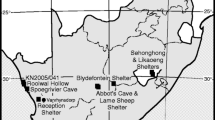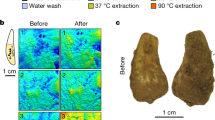Abstract
Evolutionary biologists are increasingly relying on ancient DNA from archaeological animal bones to study processes such as domestication and population dispersals. As many animal bones found on archaeological sites are likely to have been cooked, the potential for DNA preservation must be carefully considered to maximise the chance of amplification success. Here, we assess the preservation of mitochondrial DNA in a medieval cattle bone assemblage from Coppergate, York, UK. These bones have variable degrees of thermal alterations to bone collagen fibrils, indicative of cooking. Our results show that DNA preservation is not reliant on the presence of intact collagen fibrils. In fact, a greater number of template molecules could be extracted from bones with damaged collagen. We conclude that moderate heating of bone may enhance the retention of DNA fragments. Our results also indicate that ancient DNA preservation is highly variable, even within a relatively recent assemblage from contexts conducive to organic preservation, and that diagenetic parameters based on protein diagenesis are not always useful for predicting ancient DNA survival.




Similar content being viewed by others
References
Barnes I, Young JPW, Dobney KM (2000) DNA-based identification of goose species from two archaeological sites in Lincolnshire. J Archaeol Sci 27:91–100. doi:10.1006/jasc.1999.0440
Bell LS, Skinner MF, Jones SJ (1996) The speed of post mortem change to the human skeleton and its taphonomic significance. Forensic Sci Int 82:129–140. doi:10.1016/0379-0738(96)01984-6
Bollongino R, Edwards CJ, Alt KW, Burger J, Bradley DG (2006) Early history of European domestic cattle as revealed by ancient DNA. Biol Lett 2:155–159. doi:10.1098/rsbl.2005.0404
Briggs AW, Stenzel U, Johnson PL, Green RE, Kelso J, Prüfer K, Meyer M, Krause J, Ronan MT, Lachmann M, Pääbo S (2007) Patterns of damage in genomic DNA sequences from a Neanderthal. Proc Natl Acad Sci U.S.A. 104:14616–14621. doi:10.1073/pnas.0704665104
Brotherton P, Endicott P, Sanchez JJ, Beaumont M, Barnett R, Austin J, Cooper A (2007) Novel high-resolution characterization of ancient DNA reveals C > U-type base modification events as the sole cause of post mortem miscoding lesions. Nucleic Acids Res 35:5717–57128. doi:10.1093/nar/gkm588
Buckley M, Walker A, Ho SY, Yang Y, Smith C, Ashton P, Oates JT, Cappellini E, Koon H, Penkman K, Elsworth B, Ashford D, Solazzo C, Andrews P, Strahler J, Shapiro B, Ostrom P, Gandhi H, Miller W, Raney B, Zylber MI, Gilbert MT, Prigodich RV, Ryan M, Rijsdijk KF, Janoo A, Collins MJ (2008) Comment on “Protein sequences from mastodon and Tyrannosaurus rex revealed by mass spectrometry”. Science 319:33. doi:10.1126/science.1147046
Budowle B, Moretti T, Smith J, Dizinno J (2000) DNA typing protocols: molecular biology and forensic analysis. Eaton, Natick
Colgan S, O’Brien L, Maher M, Shilton N, McDonnell K, Ward S (2001) Development of a DNA-based assay for species identification in meat and bone meal. Food Res Int 34:409–414. doi:10.1016/S0963-9969(00)00185-X
Colson IB, Bailey JB, Vercauteren M, Sykes B, Hedges R (1997) The preservation of Ancient DNA and bone diagenesis. Ancient Biomol 1:109–117
Cooper A (1992) Removal of colourings, inhibitors of PCR, and the carrier effect of PCR contamination from ancient DNA samples. Anc DNA Newslett 1:31–32
Cooper A, Poinar HN (2000) Ancient DNA: do it right or not at all. Science 289:1139. doi:10.1126/science.289.5482.1139b
Deagle B, Eveson JP, Jarman S (2006) Quantification of damage in DNA recovered from highly degraded samples—a case study on DNA in faeces. Front Zool 3:11. doi:10.1186/1742-9994-3-11
Edwards CJ, MacHugh DE, Keith M, Dobney KM, Martin L, Russell N, Horwitz KL, McIntosh SK, MacDonald KC, Helmer D, Tresset A, Vigne JD, Bradley DG (2004) Ancient DNA analysis of 101 cattle remains: limits and prospects. J Archaeol Sci 31:695–710. doi:10.1016/j.jas.2003.11.001
Edwards CJ, Bollongino R, Scheu A, Chamberlain A, Tresset A, Vigne JD, Baird JF, Larson G, Ho SY, Heupink TH, Shapiro B, Freeman AR, Thomas MG, Arbogast RM, Arndt B, Bartosiewicz L, Benecke N, Budja M, Chaix L, Choyke AM, Coqueugniot E, Döhle HJ, Göldner H, Hartz S, Helmer D, Herzig B, Hongo H, Mashkour M, Ozdogan M, Pucher E, Roth G, Schade-Lindig S, Schmölcke U, Schulting RJ, Stephan E, Uerpmann HP, Vörös I, Voytek B, Bradley DG, Burger J (2007) Mitochondrial DNA analysis shows a Near Eastern Neolithic origin for domestic cattle and no indication of domestication of European aurochs. Proc Biol Sci 274:1377–1385. doi:10.1098/rspb.2007.0020
Gilbert MTP, Rudbeck L, Willerslev E, Hansen AJ, Smith C, Penkman KE, Prangenberg K, Nielsen-Marsh CM, Jans ME, Arthur P, Lynnerup N, Turner-Walker G, Biddle M, Kjølbye-Biddle B, Collins MJ (2005) Biochemical and physical correlates of DNA contamination in archaeological human bones and teeth excavated at Matera, Italy. J Archaeol Sci 32:785–793. doi:10.1016/j.jas.2004.12.008
Gilbert MT, Binladen J, Miller W, Wiuf C, Willerslev E, Poinar HN, Carlson JE, Leebens-Mack JH, Schuster SC (2006) Recharacterization of ancient DNA miscoding lesions: insights in the era of sequencing-by-synthesis. Nucleic Acids Res 35:1–10. doi:10.1093/nar/gkl483
Götherström A, Anderung C, Hellborg L, Elburg R, Smith C, Bradley DG, Ellegren H (2005) Cattle domestication in the Near East was followed by hybridization with aurochs bulls in Europe. Proc Biol Sci 272:2345–2350. doi:10.1098/rspb.2005.3243
Haynes S, Searl JB, Bretman A, Dobney KM (2002) Bone preservation and ancient DNA: the application of screening methods for predicting DNA survival. J Archaeol Sci. 29:585–592. doi:10.1006/jasc.2001.0731
Hill RL (1965) Hydrolysis of proteins. Adv Protein Chem 20:37–107
Hofreiter M, Jaenicke V, Serre D, Haeseler Av A, Pääbo S (2001) DNA sequences from multiple amplifications reveal artifacts induced by cytosine deamination in ancient DNA. Nucleic Acids Res. 29:4793–4799. doi:10.1093/nar/29.23.4793
Jans MME, Nielsen-Marsh CM, Smith CI, Collins MJ, Kars H (2004) Characterisation of microbial attack on archaeological bone. J Archaeol Sci 31:87–95. doi:10.1016/j.jas.2003.07.007
Kaufman DS, Manley WF (1998) A new procedure for determining DL amino acid ratios in fossils using reverse phase liquid chromatography. Quat Sci Rev 17:987–1000. doi:10.1016/S0277-3791(97)00086-3
Kemp BM, Smith DG (2005) Use of bleach to eliminate contaminating DNA from the surface of bones and teeth. Forensic Sci Int 154:53–61. doi:10.1016/j.forsciint.2004.11.017
Koon, HEC (2006) Detecting cooked bone in the archaeological record: a study of the thermal stability and deterioration of bone collagen. PhD thesis, University of York
Koon HEC, Nicholson RA, Collins MJ (2003) A practical approach to the identification of low temperature heated bone using TEM. J Archaeol Sci 30:1393–1399. doi:10.1016/S0305-4403(03)00034-7
Kronick PL, Cooke P (1996) Thermal stabilization of collagen fibers by calcification. Connect Tissue Res 33:275–282. doi:10.3109/03008209609028885
Larson G, Albarella U, Dobney K, Rowley-Conwy P, Schibler J, Tresset A, Vigne JD, Edwards CJ, Schlumbaum A, Dinu A, Balaçsescu A, Dolman G, Tagliacozzo A, Manaseryan N, Miracle P, Van Wijngaarden-Bakker L, Masseti M, Bradley DG, Cooper A (2007) Ancient DNA, pig domestication, and the spread of the Neolithic into Europe. Proc Natl Acad Sci USA 104:15276–15281. doi:10.1073/pnas.0703411104
Leonard JA, Shanks O, Hofreiter M, Kreuz E, Hodges L, Ream W, Wayne RK Fleischer RC (2007) Animal DNA in PCR reagents plagues ancient DNA research. J Arch Sci 34:1361–1366. doi:10.1016/j.jas.2006.10.023
Lindahl T, Nyberg B (1972) Rate of depurination of native deoxyribonucleic acid. Biochem 11:3610. doi:10.1021/bi00769a018
Malmström H, Stora J, Dalen L, Holmlund G, Götherström A (2005) Extensive human DNA contamination in extracts from ancient dog bones and teeth. Mol Biol Evol 22:2040–2047. doi:10.1093/molbev/msi195
Malmström H, Svensson EM, Gilbert MT, Willerslev E, Götherström A, Holmlund G (2007) More on contamination: the use of asymmetric molecular behaviour to identify authentic ancient human DNA. Mol Biol Evol 24:998–1004. doi:10.1093/molbev/msm015
Newman ME, Parboosingh SE, Bridgeb PJ, Howard C (2002) Identification of Archaeological Animal Bone by PCR/DNA Analysis. J Archaeol Sci. doi:10.1006/jasc.2001.0688
Nicholson RA (1993) A morphological investigation of burnt animal bone and an evaluation of it utility in archaeology. J Archaeol Sci 20:411–428. doi:10.1006/jasc.1993.1025
Noonan JP, Hofreiter M, Smith D, Priest JR, Rohland N, Rabeder G, Krause J, Detter JC, Pääbo S, Rubin EM (2005) Genomic sequencing of Pleistocene cave bears. Science 309:597–600. doi:10.1126/science.1113485 2005
O’Connor TP (1989) Bones from Anglo-Scandinavian Levels at 16–22 Coppergate. The Archaeology of York 15 (3). Council for British Archaeology, London
Pääbo S, Poinar H, Serre D, Jaenicke-Despres V, Hebler J, Rohland N, Kuch M, Krause J, Vigilant L, Hofreiter M (2004) Genetic analyses from ancient DNA. Annu Rev Genet 38:645–679. doi:10.1146/annurev.genet.37.110801.143214
Poinar HN, Stankiewicz AB (1999) Protein preservation and DNA retrieval from ancient tissues. Proc Natl Acad Sci USA 96:8426–8431. doi:10.1073/pnas.96.15.8426
Poinar HN, Hoss M, Bada JL, Pääbo S (1996) Amino acid racemization and the preservation of ancient DNA. Science 272:864–866. doi:10.1126/science.272.5263.864
Roberts S, Smith C, Millard R, Collins MJ (2002) The taphonomy of cooked bone: characterizing boiling and its physico-chemical effects. Archaeometry 44:485–494. doi:10.1111/1475-4754.t01-1-00080
Rohland N, Hofreiter M (2007) Comparison and optimization of ancient DNA extraction. Biotechniques 42:343–352. doi:10.2144/000112383
Salamon M, Tuross N, Arensburg B, Weiner S (2005) Relatively well preserved DNA is present in the crystal aggregates of fossil bones. Proc Natl Acad Sci USA 102:13783–13788. doi:10.1073/pnas.0503718102
Shipman P, Foster GF, Schoeniger M (1984) Burnt bones and teeth: an experimental study of colour, morphology, crystal structure and shrinkage. J Archaeol Sci 11:307–325
Smith CI, Chamberlain AT, Riley MS, Stringer C, Collins MJ (2003) The thermal history of human fossils and the likelihood of successful DNA amplification. J Hum Evol 45:203–217. doi:10.1016/S0047-2484(03)00106-4
Svensson EM, Götherström A, Vretemark M (2008) A DNA test for sex identification in cattle confirms osteometric results. J Arch Sci 35:942–946. doi:10.1016/j.jas.2007.06.021
Troy CS, MacHugh DE, Bailey JF, Magee DA, Loftus RT, Cunningham P, Chamberlain AT, Sykes BC, Bradley DG (2001) Genetic evidence for Near-Eastern origins of European cattle. Nature 410(6832):1088–1091. doi:10.1038/35074088
Turner-Walker G, Nielsen-Marsh CM, Syversen U, Kars H, Collins MJ (2002) Sub-micron spongiform porosity is the major ultra-structural alteration occurring in archaeological bone. Int J Osteoarchaeol 12:407–414. doi:10.1002/oa.642
Zoledziewska M, Gronkiewicz S, Dobosz T (2002) Comparison of various decalcificators in preparation of DNA from human rib bones. Anthropol Rev 65:75–80
Acknowledgements
We wish to thank Professor O’Connor (University of York) for providing the archaeological samples from Coppergate, York. We thank Dr. Tom Gilbert for his useful advice for designing the qPCR and sequencing reactions. We also thank the European Commission (Marie Curie Mobility Actions; MEIF-CT-2004-0100) and the Ministero dell’Istruzione, dell’Università e della Ricerca (Programmi di Ricerca Scientifica di Rilevante Interesse Nazionale; prot. # 2005057557, allotted to O.R.) for supporting this work as well as NERC (GR9/4760; NERC/S/A/2002/12028) and the Wellcome Trust for supporting the amino acid and collagen analyses and three anonymous referees for their useful comments. The experiments reported in this study comply with the current laws of Italy and the United Kingdom where they were performed.
Author information
Authors and Affiliations
Corresponding author
Rights and permissions
About this article
Cite this article
Ottoni, C., Koon, H.E.C., Collins, M.J. et al. Preservation of ancient DNA in thermally damaged archaeological bone. Naturwissenschaften 96, 267–278 (2009). https://doi.org/10.1007/s00114-008-0478-5
Received:
Revised:
Accepted:
Published:
Issue Date:
DOI: https://doi.org/10.1007/s00114-008-0478-5




